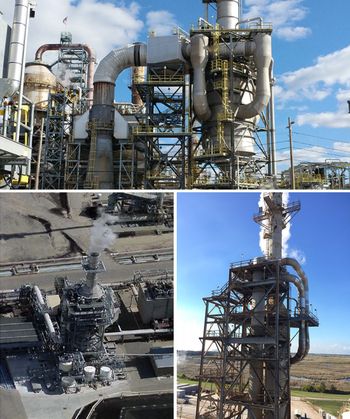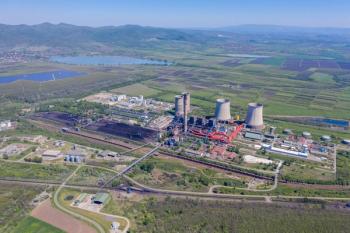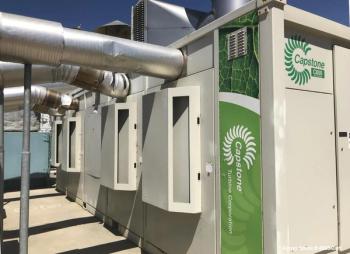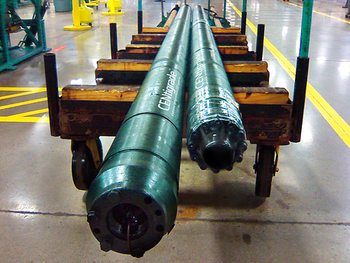
Hydrogen Retrofits Support Gas Turbines' Role in a Clean Energy Future
Jeffrey Benoit of PSM and Bobby Noble of EPRI talk about the battle for grid stability from intermittent renewables and how retrofitted gas turbines can enhance reliability.
After the opening keynote, Jeffrey Benoit, Vice President of Clean Energy Solutions at PSM - a Hanwha company, led the session, Future-Proofing Gas Turbines with Hydrogen Retrofits, with chairperson Bobby Noble, Senior Program Manager, Gas Turbine R&D – EPRI.
As renewable energy continues to reshape the grid, its inherent volatility and intermittency require a reliable balancing solution to ensure a smooth transition to clean power. Opportunities lie in retrofitting existing natural gas turbines with advanced combustion technology to accommodate hydrogen fuel.
Turbomachinery International spoke with Benoit and Noble about the most significant challenges and technological advancements in this area and where these types of hydrogen-fueled gas turbine + renewables setups work best.
TURBO: What are the biggest challenges with introducing renewables to the grid in terms of reliability?
Benoit: Grid stability. The inherent intermittency and variability of solar and wind, driven by weather conditions and daily cycles, can cause significant fluctuations in voltage and frequency. Maintaining a balance between generation and demand is a constant battle, and as more renewables are added, robust yet complementary solutions must be implemented. Depending on the grid size, many ways exist to mitigate this issue.
First, introducing batteries as energy storage (BESS) can help regulate grid stability by rapidly responding to supply and demand variations. Another option is gas turbines, which provide tremendous inertia, which means their rotating mass acts as a buffer to act as a shock absorber for the grid essentially. Another challenge is locating a grid’s solar capacity in one concentrated location. This makes an incoming cloud or storm front force cycling of dispatchable assets like gas turbines or batteries.
Noble: Generally, society has come to expect high reliability, especially in the United States and many parts of Europe. Ensuring 99.999% reliability is becoming an ever-growing challenge as renewable penetration increases. This comes from multiple factors, and having optionality for the energy transition is critical for cost-effective reliability.These challenges have different levels at different times of the year, inother regions, and where energy mixes may be more limited.
TURBO: What advanced combustion technologies make hydrogen fuel possible in gas turbines?
Benoit: The introduction of fuel-injection combustor micromixers is one of them. This approach allows for extremely fine-scale mixing of hydrogen and air, providing a very uniform combustion process and preventing hot spots that can cause high NOx emissions and flashback. Hydrogen reacts very quickly, so micromixers not only allow uniformity in fuel-air distribution but can allow very high velocities of the reacting flow, preventing the hydrogen fuel-and-air mixture from burning inside the micromixer fuel injector, which would cause catastrophic damage. We want to prevent flashback.
Another is trapped vortex flame stabilization, where a high-velocity hydrogen-air mixture is oxidized using, for example, a circumferential cavity around the combustion chamber, which allows stable combustion at very high velocities.
Finally, fuel injection staging allows the hydrogen fuel to be introduced and oxidized in different axial locations within the combustion chamber. This enables the necessary energy to be released and oxidized but minimizes the potential for flashback and high NOx emissions. PSM’s HyFlex FlameSheet combustor utilizes all three technologies to reach upwards of 100% hydrogen fuel in a lean premix combustion process without using diluents like steam or water for emissions abatement. In addition, it is fully capable of operating on natural gas or any blend of natural and hydrogen.
Noble: Micromixers and staged combustion are allowing for wider fuel adoption. Continued work is needed to push to 100% capability, but this is occurring with the major OEMs and third-party providers.
TURBO: What does a gas turbine retrofit entail?
Benoit: The complexity level and scope will increase depending on the absolute amount of hydrogen the turbine operator wants to consume or is available. Existing dry lean premix gas turbine combustion systems were designed to burn just natural gas and optimized for very low NOx emissions but could tolerate small amounts of hydrogen before potential flashback. For lower levels of hydrogen, it could be just a mixing station allowing hydrogen and natural gas to mix before going into the combustion fuel delivery skid system. For higher levels of hydrogen, the existing combustor would likely need to be removed, and a new high-hydrogen-capable combustor would need to be installed, along with the mixing station and some valve modifications in the existing fuel skid system.
Existing manifolds delivering the mixed fuel blend would remain. Still, if there is a variable flow of hydrogen and natural gas, we recommend also adding our combustion AutoTune System, an autonomous, real-time digital tool. This system continuously calculates the fuel-mixture heating value and modulates the combustor’s fuel-injection system parameters to maintain stability, emissions, and combustion dynamics (which can cause excessive mechanical wear).
Suppose you want to consume from 50% to 100% hydrogen in a mixture with natural gas. In that case, the combustion system must be replaced, and the entire existing fuel delivery skid and fuel manifolds to each combustor must also be replaced. The reason for this is that hydrogen takes up significantly more volume to deliver the same amount of energy, so to keep the piping velocities within design conditions and the fuel system operating properly, all the piping and valves need to be sized for the maximum amount of hydrogen to be used. PSM and our sister company, Thomassen Energy, completed this retrofit on our Frame 7E gas turbine power plant validation facility in Daesan, Korea, in 2023. We could then fully commission the entire system and validate our FlameSheet combustion system.So, we have fuel delivery and combustion systems designs available that we can deliver and commission based on a power plant operator’s needs.
Noble: This is highly unit-/site-dependent but likely will involve changes from the fuel supply lines to the combustion hardware inside the gas turbine.
TURBO: How do hydrogen-fueled gas turbines and renewables work well together and increase reliability?
Benoit: As I mentioned before, gas turbines can provide a solid buffer to the inherent intermittency of renewables that can cause voltage and frequency variability.One way a hydrogen gas turbine complements renewables nicely is in an ecosystem operating together; one can deliver extremely reliable, potentially 24/7 carbon-free power generation when you throw in some BESS. The gas turbine would act primarily as a dispatchable peaker—deployed during “Dunkelflaute,” a period of no wind or sun—and meet the power demand. This makes sense for data centers, for example.
One challenge today is the volume of hydrogen available and how to store it locally or regionally for a peaker’s needs. However, PSM’s FlameSheet combustor not only improves operational range, emissions, and maintenance lifecycle costs, but it, in essence, future-proofs the turbine so that when using natural gas in the interim or blended with available hydrogen, it’s a “one-and-done” combustor retrofit upgrade. All that’s then needed is a fuel skid delivery system upgrade as more hydrogen becomes available to utilize—a great circular economy example.
Noble: From an optional standpoint, this could allow for an energy storage method with hydrogen during peak renewable generation and utilization of that hydrogen at off-peak times within the gas turbine. Of course, this would require a massive over-installation of renewables, making other avenues for hydrogen production a more probable means.
TURBO: How does natural gas fit into retrofitted gas turbines – does it still have a role?
Benoit: Natural gas is plentiful, widely available, relatively inexpensive, and suitable for use in gas turbines. Gas turbines for power generation became very reliable during the mid-980s, enough that they could be used for baseload and cyclic power, a nice complement to coal and nuclear power. I see three ways today where natural gas can fit as a longer-term use fuel while we bridge/transition to much more renewables, BESS, and plentiful hydrogen (and possibly fuel cells instead of turbines, but way out there).
First, natural gas can be repurposed via steam methane reforming (SMR), auto-thermal reforming (ATR), and natural gas pyrolysis with carbon capture and sequestration (CCS). The resulting hydrogen can be used for industrial purposes, such as ammonia production, desulfurization of fuel oil, mobility, and gas turbine peakers.
I also see using renewable natural gas as a longer-term use case, as we have massive organic waste that could be efficiently harvested (location-dependent). Both uses complement the continued growth of renewables that generate hydrogen as turbines go more into a more complementary balancing purpose.
Noble: Keeping optionality will help bolster these units' reliability and availability. Moreover, carbon capture is still a promising means of reducing carbon emissions.
TURBO: Where/when is the setup (clean hydrogen + renewables) a good fit, given the challenges clean hydrogen presents in terms of efficiencies and energy losses during production, cost, etc.?
Benoit:I see good use cases in developing clean-energy ecosystems where gas turbines with hydrogen are used sparingly to be that “last mile” to ensure reliable delivery.I also see gas turbines and hydrogen being used in clean ammonia production facilities, where natural gas is reformed into hydrogen with CCS (along with lots of green hydrogen) to make the ammonia, where inside the fence, power and mechanical drives for compressors can utilize a portion of the production stream.
I agree that efficiencies and energy losses are a concern today, but we are nowhere near where advancing technology will bring us and are early in the emerging clean-energy transition, so production processes are nowhere near commercialized scale. Wind and solar are relatively cheap today, fostered by production and investment tax credits, some since 1992, and other technology development incentives and credits.
A recent example is an award for an onshore solar project in Abu Dhabi at Al Ajban that produces unsubsidized power at $14/MW-hour. Wind turbines are now being installed offshore, generating upwards of 20 MW each.
TURBO: What is the projected timeline for these types of projects?
Benoit: PSM has already implemented our HyFlex FlameSheet combustion system into four commercial applications: a 25-MW GE Frame 5, an 80-MW GE Frame 7E in Korea, and GE Frame 7F and Siemens Westinghouse 501Fs in the United States.
To date, over 30 turbines are running with the FlameSheet combustor installed, two of which utilize hydrogen-rich refinery waste gas in or adjacent to oil or petrochemical facilities in the United States. Systems for upwards of 100% hydrogen are commercially available for the Frame 5PA gas turbine and are in the final stages of development for the Frame 6B Frame 7E. We believe the first adoptions will apply to smaller peaker turbines, where they make strategic and financial sense for their users and minimize the practical challenges of large volumes of hydrogen production and storage. Start small to go big!
Newsletter
Power your knowledge with the latest in turbine technology, engineering advances, and energy solutions—subscribe to Turbomachinery International today.




